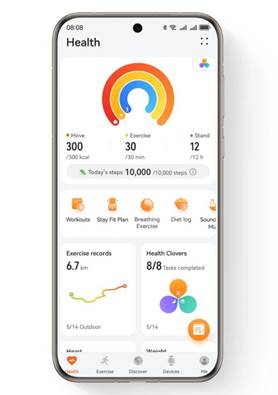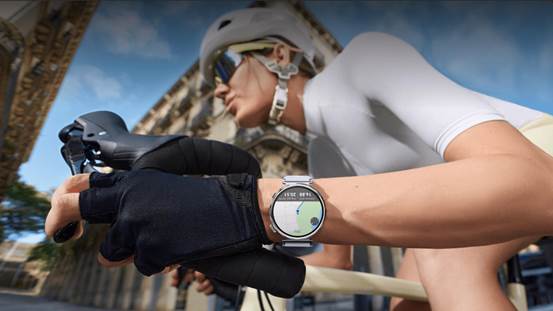Can Wearables Help Manage Stress and Anxiety?
Stress and anxiety can disrupt everyday routines,
impair sleep, and compromise long-term health. Many individuals resort to
lifestyle adjustments and therapy, but technology now adds another layer of
assistance. Wearables with powerful health-tracking sensors provide users with
real-time feedback on how their bodies respond to pressure. Devices like the
Huawei Watch GT6 Pro, which runs HarmonyOS 6.0, combine an attractive
appearance with accurate stress detection. Wearables that detect heart rate
variability (HRV), emotional moods, and sleep quality assist users in
identifying triggers and acting quickly. The issue is, can they really
alleviate stress and anxiety?

Why Use Wearables for Stress?
Understanding Stress and Its Impact
Stress causes bodily effects, including elevated
heart rate and cortisol levels. Short-term stress improves concentration, but
persistent stress causes sleep problems, decreased immunity, and an increased
risk of anxiety disorders. Managing it necessitates awareness and prompt
treatment. Wearables aid by converting unseen signals into visible data.
Real-time HRV monitoring, for example, may detect when the body swings from a calm
to a tense state. Users who receive daily feedback can identify dangerous tendencies
quickly than they would otherwise. This early detection is crucial for ending
stress cycles before they become more serious emotional or physical health
issues.
Role of Technology in Mental Wellbeing
Technology has evolved beyond exercise to become a
wellness companion. Modern wearable devices monitor not just steps and
calories, but also mood, stress, and recuperation. The Huawei Watch GT6 Pro has
improved sensing with the TruSense System, resulting in quicker and more
accurate emotional and stress detection. Users may have a better understanding
of how their lifestyle impacts their mind and body thanks to features such as
continuous heart health monitoring. When combined with HarmonyOS 6.0, the
device offers customized watch faces, alerts, and guided breathing exercises.
These tech-driven insights provide consumers with practical solutions to
encourage better habits and maintain a balanced mental state over time.
Growing Popularity of Stress-Tracking Devices
Wearables that detect stress are becoming more
popular as individuals seek proactive control over their health. The rise of
gadgets such as the Huawei Watch GT6 Pro demonstrates this transition. Its
aerospace-grade titanium body, nano-ceramic back, and sapphire glass ensure
longevity, while the innovative stress monitoring technology makes it suitable
for daily usage. Fitness fans enjoy the way it combines mental health checks
with workout capabilities such as cycle power measures and ski monitoring. Users
like its long-lasting battery and IP69 water resistance. As wearables improve
in accuracy, they will no longer be considered luxury items but rather popular
stress relief solutions.

Can Wearables Really Reduce Stress and Anxiety?
Benefits of Biofeedback and Real-Time Alerts
Biofeedback turns biological signals into actionable guidance. When a wearable detects rising stress, it can prompt users with alerts or suggest breathing exercises. The Huawei watch gt6 pro, for example, monitors HRV, sleep quality, and emotional state in real time. Its improved sensor accuracy guarantees that consumers receive timely prompts to halt, relax, or modify activities. People can avoid extended stress by responding to these signals. Over time, the brain develops a natural ability to detect these signals, which strengthens self-regulation. This feedback loop, powered by precision technology, enables individuals to reduce anxiety before it becomes overpowering or persistent.
Encouraging Healthy Lifestyle Habits
Wearables promote longer-term resilience by
encouraging healthy habits. The Huawei Watch GT6 Pro does more than just detect
stress; it also leads exercises, records recuperation, and encourages better
sleep. Its athletic modes, such as cycling and outdoor running, use stress data
to recommend balanced training. The all-day stress monitoring includes
reminders to remain active, drink, and take thoughtful pauses. Even its sturdy
construction, which includes triple protection against water and dust, allows
customers to use it without concern. By integrating physical exercise with
emotional awareness, the gadget promotes behaviors that naturally reduce stress
and improve mental and physical wellbeing.
Conclusion
Wearables cannot replace therapy or medical
treatment, but they are effective tools for stress monitoring and management.
Devices such as the Huawei Watch GT6 Pro demonstrate how technology has
progressed beyond fitness to encompass overall wellbeing. Users gain real-time
insights on stress and mental wellness thanks to precise sensors, a sturdy
design, and the seamless experience of HarmonyOS 6.0. By integrating data and
suggested actions, these wearables promote better behaviors and speedier
recovery from stressors. The increased demand for stress-tracking tools
demonstrates that individuals believe technology can help them manage their
mental health. For individuals seeking balance, wearables provide a realistic
solution to control anxiety on a daily basis.


